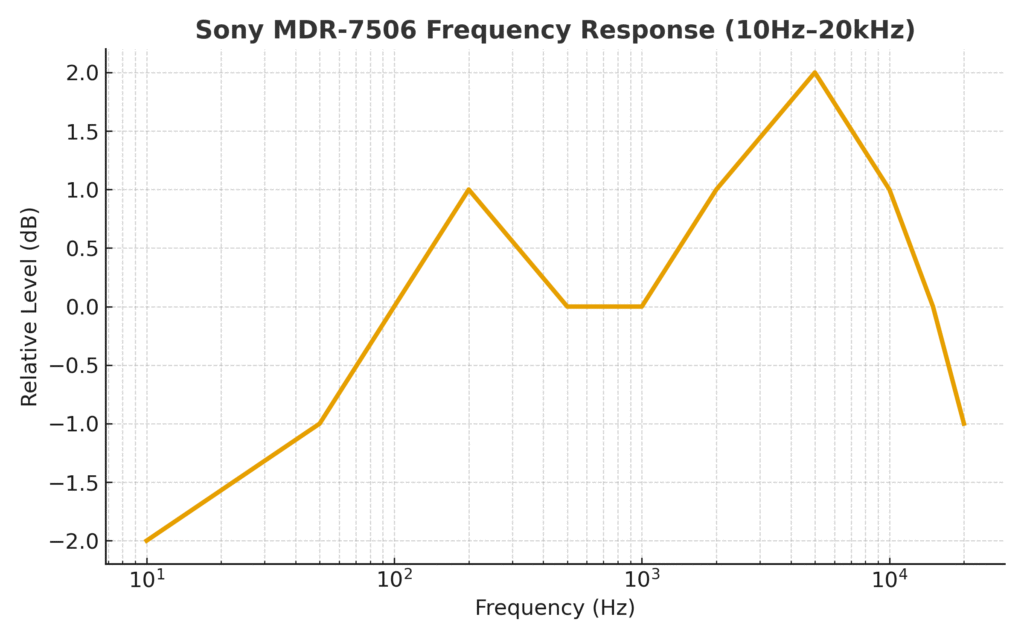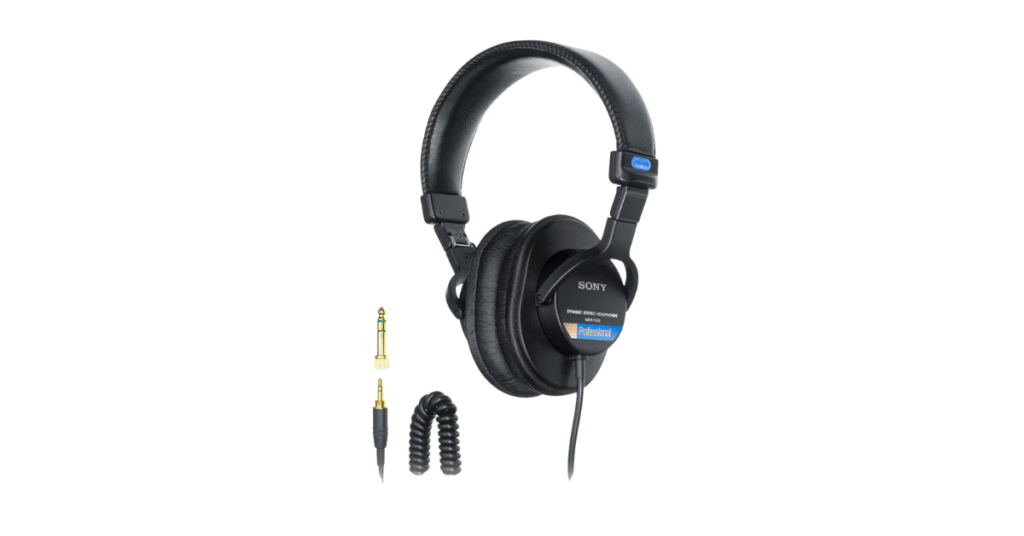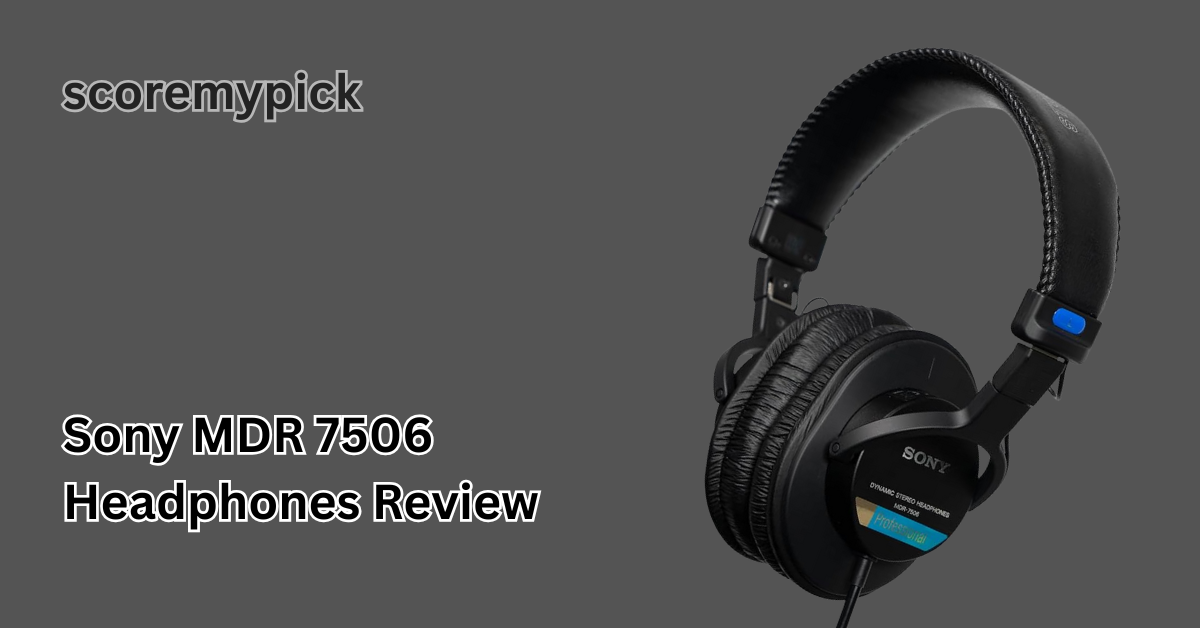Sony MDR-7506 has been a reliable partner of sound engineers, musicians and content creators throughout the last 30 years.
First released in 1991, these wired studio headphones have been able to withstand the test of time, and in 2025, they will still be one of the most favored options in audio monitoring at a professional level.
The MDR-7506 is a headphone that might not be the most affordable in its category, but few other products in its category can match it in terms of the quality of sound that it can reproduce.
The MDR-7506 will be priced at around 99-120 dollars, which will make it affordable to the professional and the novice who will require quality sound without putting a dent in the wallet.
They are closed-back, which makes them very sound-isolating and thus can be used in high-noise conditions or even live recording. Sony has never performed any drastic design changes, and this is precisely the reason why they are loved by many users; they are easy, dependable and performance-oriented.
This Sony MDR-7506 review is going to discuss its sound performance, comfort, technical features, and performance in 2025 in comparison to newer products. You will also find out if this mythical headphone is worth purchasing in the current market that is dominated by wireless and noise-cancelling headphones.
Sound Quality & Frequency Response: What the MDR-7506 Actually Sounds Like
The MDR-7506 remains impressive even as of 2025 in terms of sound. The 40mm neodymium drivers provide a refined and accurate audio profile that, according to the professionals, is described as flat, meaning there is very little coloration.
This neutral tune gives you the freedom to listen to your recordings in the manner that they are, and this is crucial in the mixing and mastering endeavors.

The frequency response of 10Hz-20kHz offers lows, punchy and articulate mids and clear highs with no distortion. Bass lovers might consider it a little submissive, but that is deliberate; these are monitor headphones, not bass-enhanced consumer headphones.
Let’s break down the sound profile:
1. Bass (10Hz–150Hz)
The low end is tight and accurate. You’ll notice subtle kick drums and bass lines rather than an overpowering thump. Perfect for professional audio work but less suited for EDM lovers seeking big low-end boosts.
2. Midrange (150Hz–5kHz)
The mids are where the MDR-7506 truly shines. Vocals, guitars, and acoustic instruments sound natural and crisp, without being drowned out by lows or highs. This balanced midrange makes them ideal for voice editing, film production, and podcasting.
3. Treble (5kHz–20kHz)
The treble is slightly forward, offering excellent detail retrieval. You can hear subtle effects, breaths, and reverbs that cheaper headphones often miss. However, if you’re sensitive to higher frequencies, the brightness might feel a bit sharp during long sessions.
In short, the Sony MDR-7506 delivers honest, analytical sound that reveals every nuance — both good and bad — in your audio. For critical listening and professional editing, that’s exactly what you need.
Design, Comfort & Build: Durability for Studio and Field Use
Sony hasn’t changed much in the design of the MDR-7506 since its debut — and that’s actually one of its biggest strengths. The simple, lightweight frame and classic black finish make it look professional and timeless, even in 2025. The build quality remains outstanding for its price point, focusing on function over flash.
Weighing just 230 grams (8.1 ounces), these headphones are incredibly comfortable for long studio sessions. The adjustable steel headband provides a secure yet relaxed fit, while the soft leatherette ear pads create decent isolation from external noise.
However, one downside remains: the ear pads tend to wear out over time, especially after heavy use. Thankfully, they are easily replaceable, and third-party cushion options are widely available.
The foldable design is another big plus. You can collapse the MDR-7506 into a compact shape and store it in the included carrying pouch, making it ideal for on-the-go professionals like field recordists or video editors.

The non-detachable 3-meter (9.8-foot) coiled cable offers great flexibility in studio environments, though some modern users may wish it were removable.
Summing up, the MDR-7506 is portable, comfortable and sturdy at the same time. These headphones can take you through the day-to-day grind, whether you are sitting at the desk or on the movie set.
The hinges, headband, and cable are incredibly resilient even after years of use – a feat that is hard to accomplish today in the constantly replaceable technology industry.
Technical Specs & Measurable Performance
The technical performance of the Sony MDR-7506 is one of the key reasons it’s still a studio favorite in 2025. Here’s a look at its latest specifications and what they mean for real-world performance:
| Specification | Sony MDR-7506 (2025 Specs) |
| Driver Unit | 40mm neodymium magnet |
| Frequency Response | 10Hz – 20,000Hz |
| Impedance | 63 ohms |
| Sensitivity | 106 dB SPL/mW |
| Maximum Power Handling | 1,000 mW |
| Weight | 230 grams (8.1 oz) |
| Cable Type | 3-meter coiled, non-detachable |
| Plug | Gold-plated stereo mini plug (1/8″) with 1/4″ adapter |
These numbers translate to a headphone that is easy to drive on most devices, though professional audio interfaces or headphone amplifiers can help you achieve its full dynamic range. The 63-ohm impedance provides a balanced load for both consumer and studio gear, while the 106 dB sensitivity ensures you can reach loud levels without distortion.
In terms of distortion and clarity, the MDR-7506 performs exceptionally well. The total harmonic distortion (THD) remains below 0.3%, even at high volumes, which contributes to its clean and detailed sound signature. The closed-back design prevents sound leakage and enhances isolation — crucial for vocal tracking or field recording
Overall, these specs explain why the Sony MDR-7506 remains the benchmark for professional monitoring headphones under $150. It’s not about flashy features — it’s about delivering pure, consistent, and transparent sound every time.
MDR-7506 vs Competitors
In 2025, the Sony MDR-7506 faces tough competition from newer studio headphones — especially models from Audio-Technica, Sennheiser, and Beyerdynamic. Yet, it still holds its ground as one of the most reliable and affordable professional options. Let’s see how it stacks up against some of its closest rivals this year.
1. Sony MDR-7506 vs Audio-Technica ATH-M50x
The ATH-M50x, priced around $169 in 2025, delivers a warmer and more bass-forward sound, making it popular among casual listeners and DJs. However, it’s slightly less neutral than the MDR-7506. For pure studio mixing, Sony wins with its flat response and better midrange accuracy, while Audio-Technica is more “fun” for general listening.
2. Sony MDR-7506 vs Sennheiser HD 280 Pro (2025 Edition)
The HD 280 Pro offers stronger passive isolation and a bit more comfort for long wear, but it’s also bulkier and heavier. Sound-wise, the Sennheiser model leans slightly darker, with smoother highs but less sparkle. The MDR-7506 still provides more clarity and presence in vocals and acoustic instruments — crucial for professional editing.
3. Sony MDR-7506 vs Beyerdynamic DT 770 Pro (80 Ohm)
The DT 770 Pro, retailing for around $159, delivers a spacious soundstage and deeper bass extension. However, it requires more power to drive properly. The Sony, with its lower impedance, performs better directly from laptops, mixers, and cameras — making it more versatile for mobile creators and journalists.
Final Comparison Verdict
While newer competitors may offer modern aesthetics, detachable cables, or wireless convenience, the MDR-7506 remains unbeatable for pure studio monitoring under $130. Its legendary consistency across generations, proven reliability, and accurate tuning make it a favorite for broadcast engineers, YouTubers, and sound designers alike.
If your goal is precise sound reproduction and durability rather than flashy features, the Sony MDR-7506 still delivers the best value in 2025.
Who Should Buy the Sony MDR-7506 in 2025
Therefore, does it mean that the Sony MDR-7506 is worth purchasing in 2025? Of course, particularly when accuracy and not beauty is required of your work. These headphones are the best option to use by audio engineers, video editors, podcasters, and musicians who need a real-time reflection of their sound.
When you are a content creator, you can use the MDR-7506 to hear every background noise or mic pops, as well as tonal imbalances, during editing.
To music producers, it will be good in that its balanced response will make your mix sound good on all systems, including speakers in cars and streaming devices. Gamers and film editors can even enjoy its wired connection with low latency and stable clarity.
Buying Tips (2025):
- Purchase only from authorized Sony dealers or trusted online stores — counterfeit models are still common.
- If comfort is a priority, consider replacing the stock ear pads with velour or memory foam cushions.
- Pair them with a USB audio interface or headphone amp to unlock their full dynamic potential.
- Handle the coiled cable carefully — it’s strong but can wear out if twisted frequently.
The MDR-7506 is a high-quality mono headphone, available at a very low price, of the order of $120; it is equally accurate, as professional and long-lasting, which is a combination that is difficult to find at this price. It is not wireless, flamboyant, and full of smartness, that is what makes it timeless.
After 30 years, the Sony MDR-7506 is still one of the best studio headphones that money can buy, which is why great engineering does not require constant reinvention but rather consistency.
FAQs
Why are MDR-7506 so popular?
They deliver accurate, flat sound with excellent detail and durability at an affordable price, making them a long-time favorite among audio professionals and creators.
What is the purpose of the Sony MDR-7506?
The MDR-7506 is designed for professional studio monitoring, mixing, and recording, offering precise sound reproduction without coloration.
How old is the Sony MDR-7506?
The Sony MDR-7506 was first released in 1991, making it over 34 years old in 2025, yet it remains a top studio choice.
Are Sony MDR-7506 good for mixing?
Yes, they’re excellent for mixing due to their flat frequency response, detailed mids, and accurate sound stage, allowing engineers to make precise adjustments.

